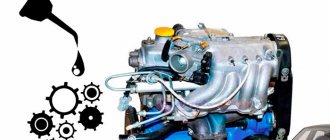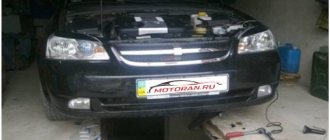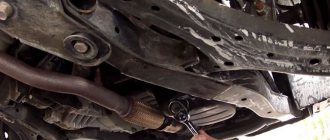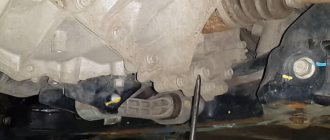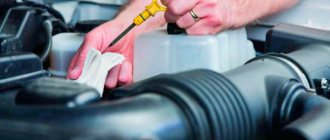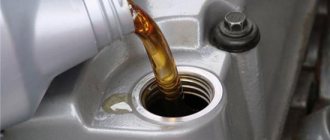- home
- Brands
- VAZ
01.09.2020
VAZ-2107 is a rear-wheel drive sedan from the classic AvtoVAZ family, produced from 1982 to 2014. It is a modernized version of the VAZ-2101, 2102 and 2103 cars. The development project for this model began in the early 70s with the aim of updating the outdated model family with the Fiat 124 design. As a result, AvtoVAZ released a whole family of cars, including the 2107 and the 2104 station wagon. Sedan 2107 is considered to be a redesigned VAZ-2105, which was produced in parallel with the “Seven”. The car was exported under different designations: Lada 1500, Signet, Riva and Nova. The successor to the VAZ-2107 in 2012 was the Lada Granta.
Oil change period in the VAZ 2107 engine
The period for changing the oil in the engine of a VAZ-2107 car is one year or every 10 thousand km. This procedure may be required much earlier if the following signs of low-quality oil are detected: cloudiness, a burning smell, the presence of wear products (in the form of sediment) or a decrease in the fluid level. As a rule, oil becomes unusable faster during sudden starts and braking in city traffic jams, with frequent driving on a dusty country road, etc. It must be borne in mind that any (even original) lubricant begins to lose its beneficial properties after 7-8 thousand km, but in harsh conditions, after 6 thousand km these useful additives can have a more negative rather than a positive effect on the engine.
Preparing for replacement
Many people advise replacing the lubricant when the power unit is warm. When the operating temperature of the power unit is reached, the lubricant acquires its initial fluidity characteristics. When flushing the engine, you need to pour a special liquid into it and let the unit run at idle speed for 10 minutes.
Before replacing the material, you should prepare a number of tools:
- the oil itself;
- an oil filter that meets the factory specifications of the power plant;
- a set of keys;
- a container where waste material will be drained;
- rags for wiping.
How much oil to pour into the VAZ 2107 engine
First generation 2107, 1982-2013
Unlike the “five,” model 2107 was equipped with a more modern 77-horsepower 1.5-liter engine, as well as an improved exterior and interior. Thus, the car received a new radiator grille in the style of old Mercedes, as well as original taillights, new front seats and a front panel with tachometers. Some interior trim elements have changed. In 2008, a version appeared with a 73-horsepower 1.5-liter engine, which had distributed injection. Total production of the 2107 was 3.1 million units.
Also read: Motor oil for Mercedes-Benz ML350 engine
Gasoline engines 1982-2012
- 1.3 64 l. With. (2105), oil volume - 3.75 liters, tolerance and viscosity: API-SG, SJ, SL, SM; SAE 5W-40, 10W-40, 10W-30, 5W-30, 0W-40, 0W-30, 20W-40
- 1.5 68 l. With. (2103), oil volume - 3.75 liters, tolerance and viscosity: API-SG, SJ, SL, SM; SAE 5W-40, 10W-40, 10W-30, 5W-30, 0W-40, 0W-30, 20W-40
- 1.5 72 l. With. (2103), oil volume - 3.75 liters, tolerance and viscosity: API-SG, SJ, SL, SM; SAE 5W-40, 10W-40, 10W-30, 5W-30, 0W-40, 0W-30, 20W-40
- 1.6 73 l. With. (2106-20), oil volume - 3.75 liters, tolerance and viscosity: API-SG, SJ, SL, SM; SAE 5W-40, 10W-40, 10W-30, 5W-30, 0W-40, 0W-30, 20W-40
- 1.6 74 l. With. (21067), oil volume - 3.75 liters, tolerance and viscosity: API-SG, SJ, SL, SM; SAE 5W-40, 10W-40, 10W-30, 5W-30, 0W-40, 0W-30, 20W-40
- 1.6 75 l. With. (2106), oil volume - 3.75 liters, tolerance and viscosity: API-SG, SJ, SL, SM; SAE 5W-40, 10W-40, 10W-30, 5W-30, 0W-40, 0W-30, 20W-40
- 1.7 79 l. With. (21213), oil volume - 3.75 liters, tolerance and viscosity: API-SG, SJ, SL, SM; SAE 5W-40, 10W-40, 10W-30, 5W-30, 0W-40, 0W-30, 20W-40
Replacing material
Before draining the used oil, you need to warm up the engine and turn it off. A container for old material is installed under the oil plug. You can unscrew this plug with a 12mm hex key.
To speed up the process of draining used lubricant, remove the cap from the oil filler neck in advance.
After the material has completely drained, you need to unscrew the oil filter using the appropriate wrench. Next, the plug on the pallet is installed in place. Now you should wipe the area where the filter is located with a rag and fill it with new grease. You also need to apply some material to the O-ring. At the end, the filter is installed in its place, after which new fluid can be added.
Upon completion of the procedure, the engine should idle for five minutes. After turning off the power unit, it is recommended to check the fastening of the filter and box and measure the lubricant level. These manipulations allow you to prevent the occurrence of leaks in advance.
What oil to use for the VAZ 2107 engine
Original
VAZ-2107 owners prefer mainly semi-synthetic oil, but you can also choose more expensive semi-synthetic or synthetic oil of varying viscosity, which is selected depending on temperature conditions. For example, for year-round operation, a 10W-40, 10W-30 or 5W-40 all-season oil is recommended. In the winter season, it is better to fill in 0W-30, 0W-40 or 5W-30, and in the summer you can opt for 20W-40 or 25W-50.
Unoriginal
Owners of VAZ-2107 cars prefer inexpensive motor oils from domestic brands Lukoil, Rosneft, G-Energy and Gazpromneft. When choosing a suitable product, it is necessary to take into account the API approval, which is selected depending on the year of manufacture of the car, as well as the type of internal combustion engine. For example, for a gasoline VAZ-2107 manufactured in 1982. All-season mineral oil with parameters 15W-20 and API-SG is suitable. For 2013 model year vehicles, pure synthetic API-SM is recommended. Below are the best options for analogue motor oils for the VAZ-2107.
- ZIC X5 10W-40
- Lukoil Lux 10W-40
- Mobil Super 3000 5W-40
- G-Energy 10W-40
- Eneos 10W-40.
Also read: Motor oil for Lada Priora engine
Types of oil
- Synthetic is the thinnest oil. Due to its fluidity, such a liquid is very resistant to low temperatures and never freezes in cold weather. Recommended for new cars, including VAZ-2107 with low mileage.
- Mineral oil is the cheapest and thickest oil. Perhaps these are all its advantages. Not suitable for low temperatures, but it will be the best option for cars with high mileage.
- Semi-synthetic is a cheaper oil than pure synthetics. But at the same time, its advantages pale in comparison to real synthetic oil. And yet, semi-synthetic is definitely better than mineral oil. Considering the fact that the car is cheap, this oil is suitable for it.
VAZ-21074 injector: the last of the “classics”
The latest classic version of the Zhiguli was the VAZ-21074, which later became one of the most popular Soviet and then Russian cars. The VAZ-21074 injector was greeted by numerous admirers of the “seventh” model with undisguised enthusiasm, and, by and large, the car as a whole met the expectations of car enthusiasts. At the time of release, the car was considered the fastest rear-wheel drive sedan of the models previously produced by the Volzhsky Automobile Plant. In 2006, in order to comply with environmental safety conditions and improve technical parameters, an injection engine began to be installed on the VAZ-21074.
Review of the VAZ-21074 injector model
The beginning of serial production of VAZ-21074 cars dates back to 1982, when the first copies of this model rolled off the assembly line of the Volzhsky Automobile Plant. At that time, the car was equipped with a carburetor power system: the injector on the VAZ-21074 appeared only in 2006. The advantages of the injection method of fuel supply are no longer a revelation to anyone, and after this system was implemented on the VAZ-21074:
- the engine began to start better in conditions of negative temperatures, without requiring prolonged warm-up;
- at idle speed the engine began to operate more smoothly and quietly;
- fuel consumption has decreased.
The disadvantages of the VAZ-21074 include:
- low location of the exhaust pipe catalyst, which increases the risk of damage to this expensive part;
- inaccessibility of some parts and sensors, which was a consequence of the fact that the old type of body was not designed for an injection system - in the carburetor version there is much more space under the hood;
- low level of noise insulation, which reduces the level of comfort of the car.
The presence of a computer control unit allows you to respond in a timely manner to the occurrence of malfunctions, since a signal about a breakdown is immediately sent to the instrument panel. The control circuit for the operation of the engine and its systems used in the VAZ-21074 allows you to control the composition of the fuel mixture, turn the fuel pump on and off using electronics, and continuously monitor all components and mechanisms.
The control scheme includes:
- Motor diagnostic block;
- Tachometer;
- Control system fault monitoring lamp;
- Throttle sensor;
- Throttle valve;
- Radiator cooling fan;
- Fan relay;
- Control block;
- Ignition coil;
- Speed sensor;
- Ignition section;
- Temperature sensor;
- Crankshaft sensor;
- Fuel pump relay;
- Fuel tank;
- Gasoline pump;
- Bypass valve;
- Safety valve;
- Gravity valve;
- Fuel filter;
- Canister purge valve;
- Reception pipe;
- Oxygen sensor;
- Battery;
- Egnition lock;
- Main relay;
- Nozzle;
- Fuel pressure control;
- Idle air control;
- Air filter;
- Air flow sensor.
A plate with identification data of the VAZ-21074 car can be found on the bottom shelf of the air intake box, which is located under the hood near the windshield, closer to the passenger seat. Next to the plate (1) is stamped VIN (2) - the vehicle identification number.
The passport data on the plate is:
- Parts number;
- Manufacturing plant;
- Indication of conformity and vehicle type approval number;
- An identification number;
- Power unit model;
- Maximum permissible force on the front axle;
- Maximum permissible load on the rear axle;
- Version and equipment;
- Maximum permitted vehicle weight;
- Maximum permitted weight with trailer.
The alphanumeric characters on the VIN number mean:
- the first three digits are the manufacturing plant code (in accordance with international standards);
- the next 6 digits are the VAZ model;
- Latin letter (or number) - year of manufacture of the model;
- the last 7 digits are the body number.
Replacement of gas tank and major repairs
Regardless of what type of fuel injection is used on your vehicle, the process for removing the tank will be the same. First drain all fuel from it. Next, carry out the following work:
- Remove the plastic casing from the container. To do this, you will need to unscrew several screws using a Phillips screwdriver.
- Disconnect the wires from the contacts leading to the fuel sensor.
- Use pliers to pry off the fuel hose.
- Unscrew the bolt of the tension plate that secures the gas tank.
- Remove the cap from the neck and carefully remove the tank.
Assess its condition. If there are several leaks or they are too large, then it will be easier to replace the entire fuel container. To do this, simply take a new tank and reassemble it in the reverse order.
If you do not have the opportunity to buy a new container, then stock up on:
- fiberglass;
- epoxy resin;
- acetone;
- sanding paper.
For injection system
Forced fuel supply in the "seven" for the Russian market began to be used in 2006. In these car models, the fan operation and other functions are performed by the ECU. On the VAZ 2107 injector, the signal about the antifreeze temperature comes from the coolant temperature sensor, which is located on the right side of the engine cylinder block.
The data is processed by the ECU, which outputs a signal to the control relay to turn on the cooling - circuit diagram. The fan switching sensor is not needed on VAZ 2107 injection systems; it is replaced by a thermistor sensor, and control functions are assigned to the controller.
In any “seven”, to protect the fan from short circuit, there is a fuse F7 located in the mounting block.
Operation of the coolant temperature sensor for the injection system
Usually, turning on the fan on a VAZ 2107 is accompanied by a noise that the driver hears while sitting behind the wheel. A prolonged absence of sound from the device when driving around the city in the summer may indicate a malfunction in the cooling system, which can lead to antifreeze boiling and damage to engine components. The driver must react quickly to such defects so as not to spoil the “heart” of his car.
One of the possible malfunctions in the engine cooling cycle may be a breakdown of the coolant temperature sensor. In addition to the cooling system, it is responsible for the correct supply of the air-fuel mixture to the engine and its inclusion in idle mode.
The sensor that affects the operation of the VAZ 2107 injector fan consists of a semiconductor thermistor with two terminals, soldered into a housing with a thread that is screwed into the wall of the cylinder block. A constant voltage of 5 V is supplied to the device. As the temperature of the antifreeze increases, the resistance of the thermistor decreases and vice versa. At the input to the computer, passing through a resistor, the voltage drops as the coolant temperature increases to a certain level, after which the controller gives a signal to turn on the cooling.
How to check and install a new one
Checking the sensor responsible for turning on the fan does not require much effort. The following signs may serve as grounds for verification:
- The “Check Engine” light on the instrument panel is on.
- The fan operates continuously or is turned off.
- Low idle torque.
- Coolant overheating.
The cause of the malfunction may be outdated wiring. To find out for sure, you need to check it, and then move on to the sensor.
For this:
- The negative cable of the battery is disconnected.
- On a cold engine, the antifreeze drains to a level below the temperature sensor socket.
- The protective layer is shifted and the wiring from the temperature sensor is disconnected.
- Use a key to unscrew the sensor from its socket.
Next, check using a multimeter and boiled water. The multimeter is connected to the outputs of the temperature sensor and set to resistance measurement mode. The threaded side is placed in boiling water. If the resistance tends to zero, then the sensor is working. Otherwise, if increased resistance readings appear, the sensor requires replacement.
To replace it, it is better to purchase the same model that was installed when purchasing the car. Installation of a new sensor occurs similarly in the opposite direction.
Salon VAZ-21074
The design of all modifications of the VAZ-2107 family (including the VAZ-21074 injector) provides for the arrangement of components and assemblies according to the so-called classical scheme, when the rear wheels are driven and the engine is shifted forward as much as possible, thereby ensuring optimal weight distribution along the axles and, as a result, improving vehicle stability. Thanks to this arrangement of the power unit, the interior turned out to be quite spacious and was located inside the wheelbase, i.e., in the zone of best ride smoothness, which could not but affect the comfort of the car.
The interior trim is made of high-quality non-glare materials. The floor is covered with mats made of non-woven material on a polypropylene base. The body pillars and doors are upholstered in semi-rigid plastic, covered on the front side with caprovelor; velutin is used for seat upholstery. The ceiling is finished with polyvinyl chloride film with a duplicated foam pad, glued to a base formed from plastic. Through the use of various mastics, layered bitumen gaskets and felt inserts:
- heat and sound insulation of the interior is achieved;
- vibration is eliminated;
- Metal components are protected from corrosion.
Video: how to improve the VAZ-21074 injector
The front seats have adjustable reclining backrests that can be moved on slides to achieve the most comfortable seating position. The rear seats are fixed.
The instrument panel of the VAZ-21074 consists of:
- Voltmeter;
- Speedometer;
- Odometer;
- Tachometer;
- Coolant temperature indicator;
- Econometer;
- Warning lamp block;
- Daily mileage indicator;
- Fuel level control lamps;
- Fuel level indicator.
When I sat down and drove off, at first I was completely confused, before that I had driven foreign cars, but here the steering wheel is twisted too tightly to press the pedal, probably the strength of an elephant is needed. I arrived, immediately drove it to a hundred, it turned out that the oil and filters in it had not been changed at all, so I changed it. Of course, it was difficult to drive at first, although the engine and gearbox suited me initially. Then it happened that I had to go far away, I almost turned gray on this trip. After 80 km I could no longer feel my back, nor my legs either; I was almost deaf from the endless roar of the engine, and when I refueled at an unknown gas station, it almost stopped altogether. I got there with no luck, I went to clean the fuel system, but they looked, they say the car is in good condition, they just haven’t modernized the rear-wheel drive since the Soviet Union. They conjured something, re-flashed it, shoved in something that couldn’t be shoved in, but the fact emerged: consumption decreased significantly, and the power was added to the machine. For this repair I paid 6 grand, there was only one more repair, when the windshield was broken with a stone, and it bounced off and left a dent on the hood, and I paid another thousand. In general, once I got used to it, everything became normal. I think the car is worth the money, the car is reliable, and there are no problems with spare parts. The most important thing is to take care of the car, change everything on time and not delay it even with a burnt-out light bulb, otherwise the consequences can lead to who knows what.
Efim
https://rauto.club/otzivi_o_vaz/156-otzyvy-o-vaz-2107-injector-vaz-2107-inzhektor.html
The gear shift pattern of a 5-speed gearbox differs from a 4-speed gearbox only in that a fifth speed has been added, to engage which you need to move the lever all the way to the right and forward.
The use of an injection fuel supply circuit in the VAZ-21074 car adds technology to the vehicle, allows you to save gasoline and control the volume of mixture supplied to the engine using electronics. Despite the fact that the model has not been produced since 2012, the VAZ-21074 continues to be in demand in the secondary market, thanks to its more than affordable price, ease of maintenance, and adaptability to Russian roads. The exterior of the car is quite easy to tune, due to which the car can be given exclusivity and its design made more relevant.
